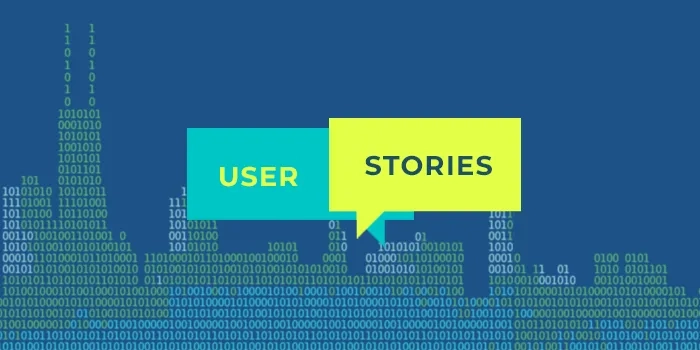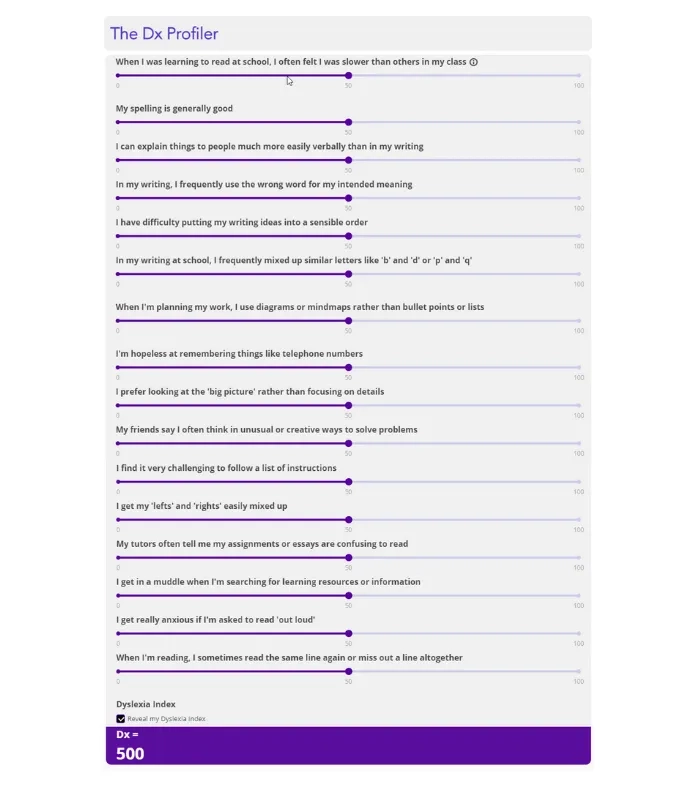User Stories: Calculator leaving a mark in Academic community - Ph.D. student uses a custom interactive calculator to assess and determine an individual's level of Dyslexia-ness

Challenge: To recreate a research assessment tool for online website use with limited coding knowledge.
Solution: Interactive Dx profiler - calculator estimating university students’ dyslexia-ness score and providing evidence about dyslexia levels for research.
Result: Finalized the Doctoral thesis and made the first publicly accessible study with an assessment of the impact of dyslexia on the academic confidence of university students.
We love unique Calconic user stories, and consider it one of the most interesting article categories on our blog. Some of our users use calculators in industries or topics we wouldn’t have thought of!
This case is outstanding because our user - Andrew Dykes completed a unique research study on university students affected by dyslexia and their academic confidence which was nowhere seen or done before and he even came up with a new term while on it. One of the tools he used for the research, was an interactive calculator! Oh, and did we mention, - now he has a Ph.D. degree!
Background and challenges
Dyslexia - is a common learning difference that is often identified by challenges with reading, writing, and spelling in children. Some estimates claim that as many as 1 in 10 people may be affected.
Different people are affected to different degrees. Challenges may include difficulties in spelling words, reading quickly, writing words, "sounding out" words in the head, pronouncing words when reading aloud, and understanding what one reads. Often these difficulties are first noticed at school, however, up to now, there was no study that explored connections between dyslexia and academic confidence in university students.
So Andrew Dykes, a student at Middlesex University London, chose this topic for a doctoral-level research study and fulfilled a personal and professional desire to become academically qualified at this level.
“No other research I have found throughout my doctoral studies has viewed dyslexia amongst university students through the lens of academic confidence in their study strategies. No one before me has coined the term 'dyslexia-ness' as an indicator of the prevalence of characteristics of dyslexia in adult learners, and no one has developed a mechanism to aggregate these into a single, numerical indicator, which I called 'Dyslexia Index.”
Dr. Andrew Dykes
The project drew from and complimented professional roles in university settings working with students as an academic guide and a dyslexia learning development professional.
He tested 3 hypotheses:
- That Non-dyslexic university students present higher levels of academic confidence than their dyslexic peers.
- Quasi-dyslexic students present higher levels of academic confidence than their dyslexic peers.
- And students whose dyslexia is diagnosed as a disability present lower levels of academic confidence than those who are told of their dyslexia in other ways.
The write-up of the research formed the thesis for his Ph.D. The study was primary research, so he had to design all the systems and processes, including the data collection and collation by himself. This included building a web-browser-based, self-report questionnaire.
The complete study was conducted online in a suite of web pages that he built. On completion of the thesis, he had to transfer the final version that was submitted to the examiners in Word format onto a fresh suite of web pages built using the WIX website-builder app. This included transferring the custom HTML5 questionnaire to a new format suitable for Wix and attractive to the eye. To do that he created an interactive calculator which automatically calculated the questionnaire results and showed the Dyslexia index.
Solution - DX Profiler
The original, working version of the 'calculator' incorporated into the e-Questionnaire was built from scratch using HTML5 input range sliders. These enabled participants in the study who were responding to the questionnaire items, to record their % of agreement with the item statements. Data was collected relating to academic confidence, and how participants' study strategies at university may have been impacted by dyslexia.

“When the completed thesis was transferred into a fresh suite of web pages using WIXSITE, I wanted to reproduce the dyslexia-ness section of the original questionnaire to incorporate into these web pages.”
Dr. Andrew Dykes
The calculator is created from a set of sliders and lets the user evaluate themselves through a set of questions. The slider ranges from 0 to 100 and at the end reveal the interviewee their dyslexia index. After that, you can check what the score means and read more about different levels of dyslexia-ness.

“I looked carefully at other calculator extensions that were integrable into WIXSITES but none of those provided the level of CSS-driven customization that I required to match the final 'calculator' to the styles and layout of my project webpages.”
Dr. Andrew Dykes
Built solely for the purpose of this research study this calculator was titled DX Profiler (the Dyslexia Index (Dx) Profiler can be found in the 'Outcomes' section of the thesis). It generates an individual's level of dyslexia-ness, that is, their Dyslexia Index (Dx) however it doesn’t indicate whether anyone is dyslexic or not.
“The WIX website builder did not provide an easy solution for building a reproduction of the original Dyslexia Index 'calculator' (which I called a 'profiler'). My HTML coding skills were not quite sufficient to get 'under the hood' of WIXSITE to tinker with the code.”
Dr. Andrew Dykes
Results
“Of the 166 students who participated in the research, just over 40% had a declared, dyslexic learning difference. Hence it was possible to compare levels of academic confidence between students with dyslexia, and their non-dyslexic peers.”
Dr. Andrew Dykes
In university, dyslexia should be viewed as a learning difference rather than a disability.
After all, some estimates claim that over 40 million American Adults are dyslexic - but only 2 million know it and this research indicated that the perception of dyslexia if it’s disclosed as a disability or disorder can affect university students’ academic confidence.
The Dx profiler served well throughout the study and will be used for further research on the topic.
Overall, all of Andrew’s hypotheses turned out to be supported by strong evidence and he’s prepared a plan for further research and development of learning tools to use in the university context! Find his final thesis and research at http://ad1281.uk/
Conclusion
Interactive calculators can indeed help the academic community build necessary tools without any coding knowledge. Such material can be used on a broad scale and asses many interviewees at the same time as well as provide them with an explanation of the results. It can also be used for personal use in further research and calculations of the student.
✌
Gintė @calconic: Hope you enjoyed Andrew's story. If you’d like to share your interactive calculator and become our next User story. Leave a comment below!

